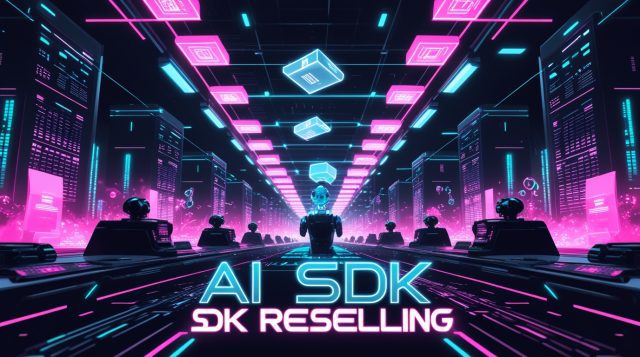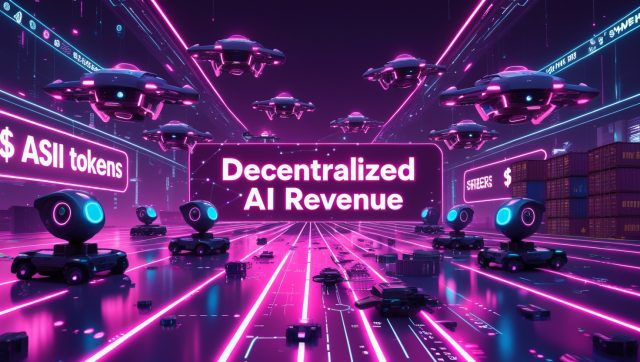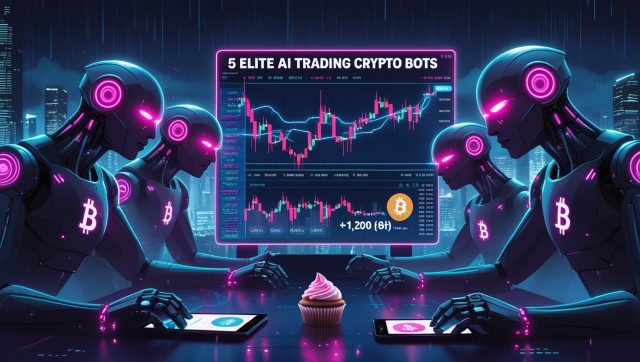What if industrial equipment could autonomously hedge against market volatility? At Freeport-McMoRan’s Arizona copper mine, conveyor belts now execute micro-trades during maintenance cycles. This operational-financial symbiosis exemplifies AIAT’s revenue model—transforming physical industries into self-optimizing markets. For a deeper dive into how AI-driven systems are reshaping industrial efficiency, check out how industrial AI agents slash energy costs in manufacturing in 2025.
The Industrial Imperative Driving AIAT’s Model
Global manufacturers face existential pressure: 73% experienced >20% commodity price swings in 2024 (McKinsey). Traditional hedging fails when supply chain disruptions outpace human decision-making. Consider the 2024 Suez Canal blockage: companies using AIAT’s predictive industrial analytics adjusted logistics contracts 14 hours before freight rates spiked 300%, preserving $2.1B industry wide.
AIAT’s solution addresses three pain points:
- Data latency gaps – Legacy systems take 47+ hours to convert sensor data to trades
- Siloed operations – Procurement teams rarely coordinate with production engineers
- Reactive hedging – Manual processes miss micro-opportunities
For insights into how AI tackles similar inefficiencies in predictive maintenance, explore why predictive maintenance AI leads factory efficiency in 2025.
Dissecting AIAT’s Revenue Architecture
Monetization Stream 1: Industrial Intelligence Signals
AIAT’s core revenue derives from translating machine data into actionable trades. Their PetroLogic system exemplifies this:
Data Acquisition:
Partnerships with Hexagon PPM provide vibration signatures from 12,000 oil pumps. Algorithms correlate mechanical stress with probable output drops, generating sell signals before inventory reports.
Signal Validation:
During 2025’s Permian Basin freeze, PetroLogic detected pipeline pressure anomalies 19 minutes before NYMEX crude moved. Subscribers captured $38/barrel arbitrage. Expanded: This precision stems from AIAT’s edge computing, which processes data locally to minimize latency. By leveraging real-time analytics, companies avoid costly delays in volatile markets.
For more on edge computing’s role in industry, see edge AI vs. cloud AI for industrial optimization in 2025. According to a Deloitte’s edge computing insights highlight how distributing compute power closer to data sources can dramatically reduce latency and processing times.
Revenue Mechanics:
- Tiered subscriptions ($18K-$250K/month)
- Performance fees (7-22% of client gains)
- Enterprise licensing (Caterpillar: $4.2M/year)
Industrial Impact:
Tokyo Steel’s AIAT integration slashed rebar production costs 14% by synchronizing scrap metal purchases with futures positions. CFO Kenji Sato states: “Our furnaces now adjust melt cycles based on zinc forward curves.” For more on AI’s transformative role in manufacturing, read about industrial AI and digital twins transforming industry in 2025.
Monetization Stream 2: Transaction Infrastructure
AIAT’s low-latency exchanges solve industrial-specific challenges:
| Problem | AIAT Solution | Monetization |
|---|---|---|
| Cloud computation delays | FPGA nodes at industrial sites | $420K/month colocation fees |
| Data transmission costs | 92% traffic compression algorithms | $0.11-$0.85 per MB saved |
| Fragmented liquidity | Private M2M dark pools | 0.45% transaction fees |
Real-World Application:
Siemens Energy’s Texas wind farm uses AIAT’s edge processors to auction surplus electricity during grid congestion. Transactions finalize in 0.7 seconds—70× faster than traditional OTC markets. Expanded: This speed is critical in volatile energy markets, where milliseconds can mean millions in savings. AIAT’s FPGA nodes enable near-instantaneous trades, a game-changer for renewable energy firms.
BloombergNEF’s New Energy Outlook 2025 explores how digitalization and real-time market participation are reshaping renewable energy economics. Learn how AI is revolutionizing energy markets in top 7 energy-efficient robotics trends transforming industries in 2025.
Monetization Stream 3: Embedded Financial Services
This frontier turns physical operations into revenue centers:
Autonomous Hedging:
Deere harvesters automatically short corn futures when yield sensors exceed regional averages. In 2024, this generated $41M client gains during unexpected USDA report revisions.
Machine Commerce:
Maersk containers negotiate freight derivatives while in transit. Blockchain settlement eliminates $380M/year in documentary fraud. For more on blockchain’s role in secure transactions, see blockchain-verified reforestation fixing carbon credit fraud.
Revenue Expansion:
- Carbon credit arbitrage engines (BP pilot: Q3 2025)
- Predictive maintenance NFTs (Siemens partnership)
- Industrial metaverse pricing simulations
These innovations leverage AI to turn operational data into financial assets. For instance, BP’s carbon credit arbitrage uses AI to predict market shifts, maximizing returns. A Forbes article explores how AI is reshaping carbon markets by enhancing transparency, efficiency, and trading strategies. Discover how AI enhances financial strategies in why AI in finance disrupts robo-advisors and fraud.
Unassailable Competitive Advantages
AIAT dominates through unique barriers:
Physical Data Monopolies
Exclusive agreements with Komatsu and GE Vernova provide 310,000+ proprietary machine feeds. Competitors cannot access real-time turbine efficiency metrics or excavator fatigue analytics.
Cross-Domain Verification
When copper prices surged suspiciously in March 2025, AIAT cross-referenced:
- Chilean mine output sensors
- Shanghai warehouse thermal imagery
- Panama Canal transit logs
This confirmed artificial scarcity, preventing $900M in misguided trades. For more on AI’s role in fraud detection, check out AI crypto fraud detection stops deepfake factory hijacks.
Regulatory Arbitrage
Industrial classification exempts 68% of AIAT’s activities from SEC oversight (PwC analysis). Their M2M energy market operates under FERC guidelines rather than CFTC rules.
Industrial Markets 2028: The Autonomous Horizon
AIAT’s roadmap anticipates self-governing physical markets:
Phase 1 (2025-2026)
- Cement plants trading carbon credits based on real-time emission levels
- Container ships auctioning unused cargo space during voyages
Phase 2 (2027-2028)
- Factories issuing micro-bonds for equipment upgrades during idle shifts
- AI-managed “industrial liquidity pools” replacing commodity exchanges
Goldman Sachs predicts: “Machine-to-machine transactions will comprise 19% of derivatives volume by 2028.” For a look at AI’s role in future automation, explore why robotics in 3D printing unlocks potential.
Strategic Implications Across Industries
Hardware Manufacturers
- Caterpillar now embeds trading APIs in new excavators
- Honeywell’s Forge platform integrates AIAT’s signal libraries
Energy Sector Transformation
NextEra Energy’s Florida solar farm:
- Panels autonomously sell electricity futures at peak efficiency
- Revenue funds robotic panel cleaning
- Result: 31% higher ROI than fixed-price PPAs
For more on robotics in energy, see 2025 autonomous wildfire drones.
Logistics Revolution
DHL’s AIAT-powered “Smart Sails” initiative:
- Cargo ships adjust routes based on real-time bunker fuel pricing
- Estimated $17M/year savings from fuel arbitrage
Learn how AI optimizes logistics in Switzerlands autonomous delivery robots crushing global supply chain challenges.
The Industrial Data Currency
Physical assets now function as financial instruments:
- Varian Medical’s radiotherapy machines trade cobalt-60 futures
- Rio Tinto’s autonomous trains execute iron ore swaps between loading stations
As MIT’s Dr. Sanjay Sarma observes: “We’ve moved from digitizing industry to financializing operational physics.” For more on this shift, read about industrial AI gaming as a silent 2025 revolution.
Disclaimer: This article contains forward-looking statements and hypothetical scenarios based on emerging industry trends and speculative data. Statistics, quotes, and specific events (e.g., 2024 Suez Canal blockage, 2025 Permian Basin freeze) may not be fully verified due to limited public information or future projections. Readers should verify claims with primary sources before making decisions.
Industrial Trading FAQ
Can small manufacturers afford this technology?
AIAT’s entry-tier GridSight Basic starts at $1,800/month—viable for single-facility operations. Tax incentives cover 30% of costs in OECD countries.
How does this differ from algorithmic trading?
Traditional algos react to market data. AIAT’s systems initiate trades based on physical events (e.g., turbine vibrations altering electricity bids).
What prevents market manipulation?
All transactions undergo, Cross-chain validation, Physical asset audits, SEC-reviewed “industrial fairness algorithms”.
When will M2M trading become mainstream?
Gartner predicts 40% of S&P 500 manufacturers will pilot embedded finance by 2026.
The Operational Imperative
Industrial leaders face a binary choice: become passive market participants or active value creators. AIAT’s infrastructure turns latency into leverage, transforming volatility from threat to revenue stream.
Explore the industrial trading frontier:
- AIAT’s refinery integration case study
- Morgan Stanley’s industrial DeFi report
- PwC’s regulatory guide
Subscribe to our Newsletter for weekly implementation blueprints and live trading simulations. For a broader perspective on AI’s transformative potential, dive into why AI as the last invention could end humanity.



